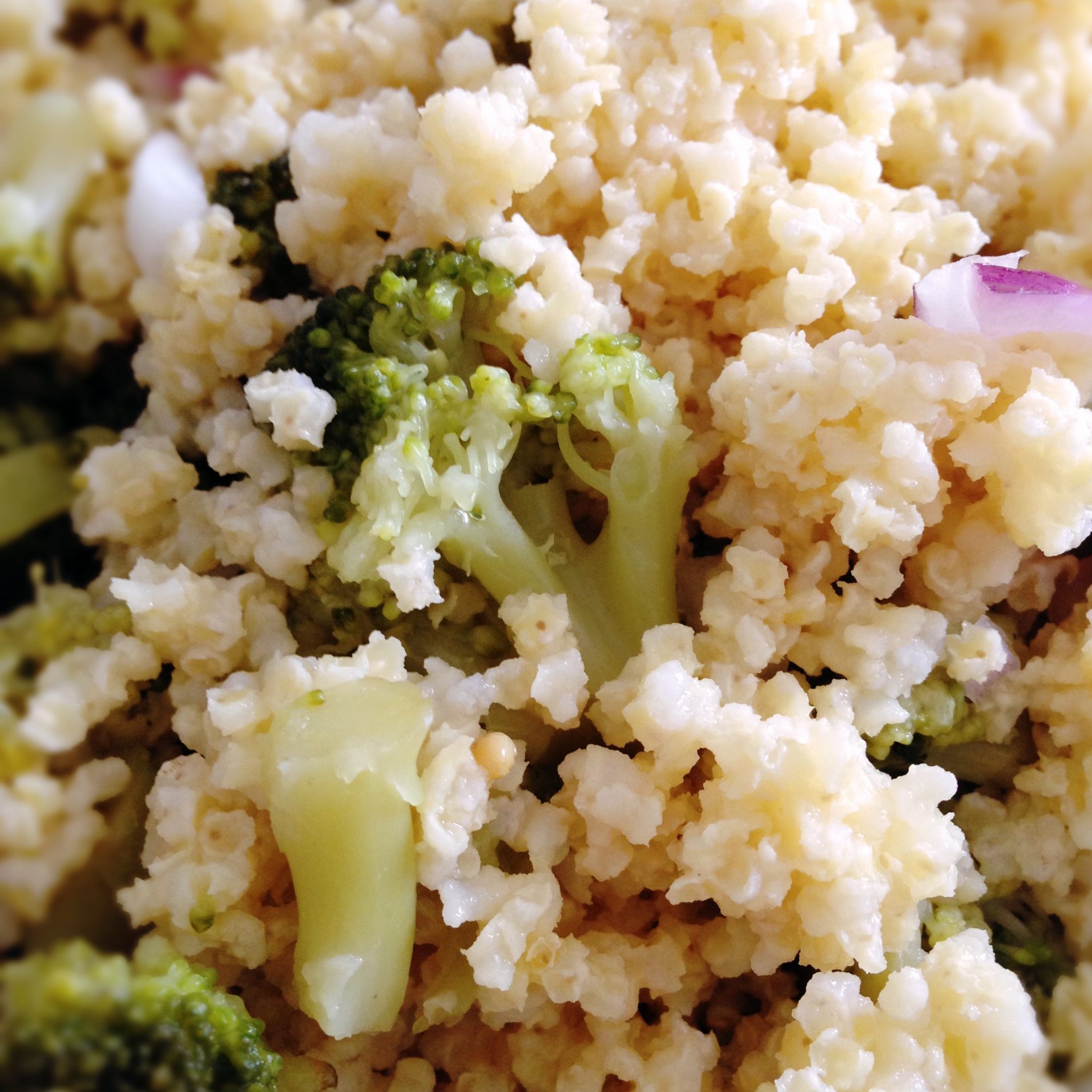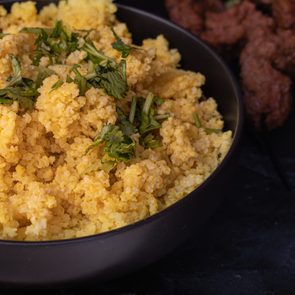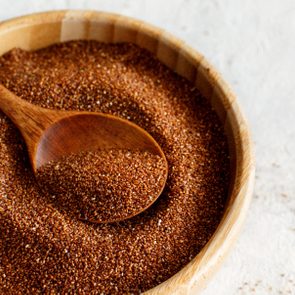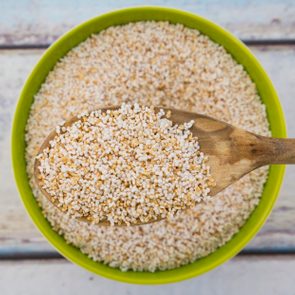Sorghum: What to Know About This Gluten-Free Grain
Updated: Mar. 30, 2022
Sorghum is a gluten-free ancient grain packed with protein, fiber, minerals, and vitamins. Learn more about its benefits and how to eat it.
What is sorghum?
You may recognize sorghum as a type of sweetener. Common in the southern United States, sorghum syrup is used in marinades and barbecue sauces, on pancakes and waffles, and for baking. The sweetener is made from stalks of sorghum grass—liquid is squeezed out and then boiled. The finished product often has similarities to maple syrup.
What many people don’t realize is that sorghum is also eaten as a grain. It’s similar to millet and a good substitute for rice or quinoa. Not only is it tasty, but it’s versatile and loaded with nutrients.
Sorghum nutrition facts
One serving of sorghum is a half of a cup of the uncooked grain; that fluffs up to about one and a half cups cooked, says Jen Hernandez, a Kentucky-based registered dietitian nutritionist.
Roughly, a serving of sorghum will deliver these nutrients:
Calories: 329
Fat: 3.5 g (4 percent of the daily recommended value, or DV)
Sodium: 2 mg (0 percent DV)
Carbohydrates: 72 g (26 percent DV)
Protein: 11 g (22 percent DV)
Fiber: 6.7 (24 percent DV)
Calcium: 13 mg (1 percent DV)
Iron: 3.7 mg (19 percent DV)
Potassium: 363 mg (8 percent DV)
Origins of sorghum
Sorghum is a type of grass in the Poaceae family, which includes fescues, lemongrass, and even bamboo. Because it’s a drought-tolerant plant, it is highly sought after, especially in regions where rainfall is scarce or in arid climates. Sorghum is a staple crop in many areas of the world, especially in Africa. It’s grown in many southern states in the United States and exported.
Health benefits of sorghum
High in antioxidants
Antioxidants are naturally occurring compounds that protect the body from harmful free radicals. Often found in plant-based foods, antioxidants can be beneficial in reducing diseases.
“It’s a good source of antioxidants in the form of phenols—phenolic acids and flavonoids—which may help lower the risk of cancer, diabetes, heart disease, and some neurological diseases,” says Abbie Gellman, registered dietitian and chef at the Institute of Culinary Education.
Foods that deliver antioxidants may also help lower inflammation. “Eating a diet rich in these antioxidants can lower oxidative stress and inflammation in your body, including the heart and circulatory system,” says Katherine Brooking, a New York-based registered dietitian.
High in protein
Protein is an essential nutrient and plays a role in a host of bodily processes. “Protein provides the building blocks for bone, muscle, skin, and enzyme development,” Brooking says.
Sorghum has plenty of plant-based protein. This is fabulous news for anyone who maintains a vegan, plant-based, or vegetarian diet.
Rich in iron
The mineral iron has an important function in the body. “Iron strengthens the immune system and oxygen-carrying capacity in the blood,” says Brooking.
If you need more iron-rich foods in your diet, look to this ancient grain. “Sorghum has 2 mg iron per serving, making it a great option to support iron-deficiency anemia,” says Hernandez.
(These are the best sources of iron you’re missing.)
Packed with fiber
Foods high in fiber are beneficial to the digestive tract and gut. And eating high-fiber foods has been linked to heart health, lower cholesterol and blood pressure, and better blood sugar control.
Like many grains, sorghum can be a great source of fiber.
“The high fiber content—8 grams per quarter-cup serving—is especially helpful for a healthy gut and GI [gastrointestinal] system,” explains Hernandez. “The high-fiber content and whole grains also support both blood pressure for hypertension and blood sugar control for diabetes management.”
Protection against disease
Sorghum may help reduce some diseases or conditions and prevent others. “Recent research has shown that some varieties of sorghum have a high level of tannins and active compounds with anti-cancer properties,” Gellman says.
The grain might make other diseases easier to manage.
Boost heart health
The various minerals, vitamins, and nutrients in sorghum make it a heart-healthy grain. “It is rich in fiber, magnesium, and potassium, which have an important role in good heart health,” says Hernandez. Fiber helps lower cholesterol and blood pressure—conditions that raise the risk of heart problems.
How does sorghum help? The mineral potassium helps maintain healthy blood pressure, says Brooking. And the vitamin niacin improves blood circulation.
Manage blood sugar for diabetes
The fiber sorghum delivers can help manage blood sugar (glucose), which is an important aspect of living with diabetes. “Fiber helps slow down absorption of glucose into the bloodstream,” says Hernandez. “I explain it to my clients like this: It’s like driving down the freeway with a semi-truck. That truck slows down the speed of traffic for surrounding smaller cars, as they need to carefully pass the truck.”
In other words, fiber keeps a food’s glucose from dumping into the blood and causing a major spike. Instead, the sugar enters at a steadier pace, helping prevent big swings in blood sugar levels.
Lower cholesterol
Incorporating sorghum into your diet can assist with cholesterol. “Soluble fiber binds to cholesterol particles, which prevents them from being absorbed into the bloodstream,” says Hernandez.
But sorghum doesn’t just lower cholesterol through its fiber content. Plant sterols in the grain help the body prevent the absorption of cholesterol. “Sorghum helps lower harmful LDL cholesterol because it’s a whole grain that has many bioactive compounds linked to cholesterol-lowering properties, including plant sterols,” Hernandez says.
Plant sterols are tricky substances. In terms of chemical structure, they’re similar to dietary cholesterol. “What happens is that when you eat plant sterols, they use up some of the cholesterol receptors in the body, so when you eat something that has cholesterol, like a steak, your body can’t absorb the cholesterol,” says Julie Upton, a registered dietitian in San Francisco. “They help block cholesterol.”
Safe for celiac disease
Gluten is found in many grains, including wheat and rye. In people with celiac disease, the protein in gluten can damage the small intestine and reduce the absorption of important nutrients. Plus, it can produce symptoms like bloating or diarrhea.
Anyone who has celiac disease or sensitivities to gluten can enjoy this grain. “Sorghum is an ancient cereal grain that is naturally gluten free, making it great for anyone with a gluten intolerance,” says Gellman.
(For another gluten-free ancient grain, try eating teff.)
Risks or side effects
In general, there aren’t any concerns with eating sorghum. But if you have potassium sensitivities or need to reduce your intake, you will need to pay attention to how much you eat.
Potassium is an important mineral that helps your muscles do their job. Normally excess potassium gets filtered out through the kidneys. But if you have chronic kidney disease (CKD), your kidneys may not be able to get rid of the potassium. As a result, it builds to potentially dangerous levels in the blood.
“If consumed in large amounts (more than two servings), it would be considered a high-potassium food,” says Hernandez. “For those with CKD and on a medically ordered potassium restriction, this could lead to severe health complications from hyperkalemia (high potassium levels in the blood), including cardiac arrest.”

How does sorghum taste?
This grain has a subtle aroma and nice texture. “Sorghum is easy to add to a variety of dishes because it has a neutral flavor,” says Gellman. “It also has more of an al dente texture or bite, which makes it great for grain salads or as a side dish.”
Types of sorghum
Sorghum comes in a variety of forms. The grain may be white, red, black, or yellow. You can buy whole grain or pearled sorghum, sorghum flour, and sorghum syrup.
How to eat sorghum
Sorghum is a versatile grain and a great staple to have on hand. How you prepare it will depend on the sorghum product you’re using. “The whole grain or pearled varieties can be cooked on the stove, in the slow cooker, oven, rice cooker, or pressure cooker,” says Gellman.
You can use it in soups, stir-fries, salads, veggie burgers, and other dishes. “I like to use it as a base for whole-grain salad bowls,” says Upton. “I add roasted and fresh veggies on top of the sorghum and then top with some beans, feta cheese, and a perky vinaigrette.”
You can also use sorghum in place of amaranth, millet, or teff. “It’s a crunchy, nutty-tasting whole grain, so you can use it as you’d use quinoa or any other ancient grain,” says Upton.
If you want a different type of snack, pop whole grain sorghum on a stove to make a nutrient-rich popcorn-like snack, says Upton.
But you’re not limited to meals you can make with whole grain sorghum. “Sorghum also comes in other forms, like whole-grain flour and syrups, meaning you can easily use it in baked goods like muffins, breads, and cookies,” says Gellman. The flour is often found in a premade gluten-free flour mixes.
Sorghum Succotash Recipe
Courtesy of Abbie Gellman, RD
Makes 4 servings
Ingredients
Succotash:
1 cup whole grain sorghum
2 cups water
1 cup edamame, shelled and defrosted
1 bell pepper, diced
1 cup corn, fresh cut off the cob or defrosted frozen
1/2 red onion, diced
1/3 cup parsley, chopped
Optional: 1/3 cup feta cheese, crumbled
Dressing:
1/4 cup extra-virgin olive oil
3 tablespoons white wine vinegar
Pinch of salt
Pinch of ground black pepper
1 teaspoon honey
Directions:
- Rinse and drain the whole grain sorghum, then pour the water and sorghum into a pressure cooker. Set the pressure cooker to high pressure for 20 minutes. Once the pressure-cooking is complete, quick release all of the pressure. Then drain the sorghum into a small sieve colander, rinse it, and fluff with a fork.
- While the sorghum is cooking, get a large bowl and add all of the dressing ingredients. Whisk together.
- Add the edamame, pepper, corn, onion, and parsley to the bowl. Add feta, if desired.
- Once the sorghum is cooked, add it to the bowl with the other ingredients and mix together.
Don’t have a pressure cooker? You can cook sorghum on the stovetop as well as according to package directions.




















